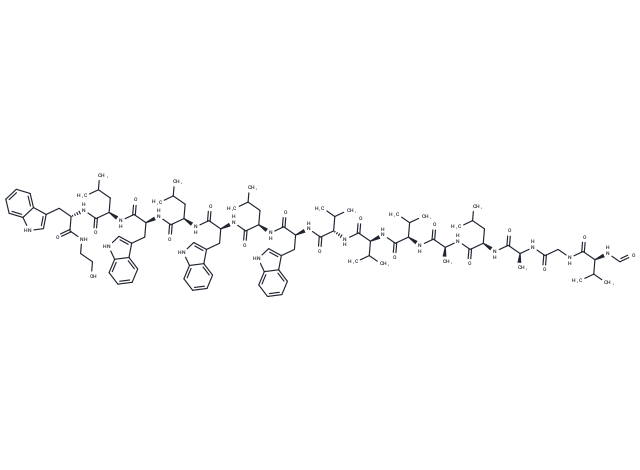Shopping Cart
- Remove All
 Your shopping cart is currently empty
Your shopping cart is currently empty

Gramicidin (Gramicidine) is an antimicrobial peptide. Gramicidin dimers form ion channel-like pores in the cell membranes and organelles of bacterial and animal cells, allowing inorganic monovalent ions, such as potassium and sodium ions, to pass freely through the pores by diffusion, disrupting the important ionic gradient between membranes and thus killing the cells by various actions. Gramicidin is effective against Gram-positive bacteria such as Bacillus subtilis and Staphylococcus aureus, but is not as effective against Gram-negative bacteria such as Escherichia coli.

| Pack Size | Price | Availability | Quantity |
|---|---|---|---|
| 25 mg | $42 | In Stock | |
| 50 mg | $50 | In Stock | |
| 100 mg | $62 | In Stock | |
| 200 mg | $88 | In Stock | |
| 1 mL x 10 mM (in DMSO) | $46 | In Stock |
| Description | Gramicidin (Gramicidine) is an antimicrobial peptide. Gramicidin dimers form ion channel-like pores in the cell membranes and organelles of bacterial and animal cells, allowing inorganic monovalent ions, such as potassium and sodium ions, to pass freely through the pores by diffusion, disrupting the important ionic gradient between membranes and thus killing the cells by various actions. Gramicidin is effective against Gram-positive bacteria such as Bacillus subtilis and Staphylococcus aureus, but is not as effective against Gram-negative bacteria such as Escherichia coli. |
| In vitro | METHODS: OC cells OVCAR8, A2780 and SKOV3 were treated with Gramicidin (0.33-3 µM) for 24-72 h. Cell viability was measured by WST-1 assay. RESULTS: Gramicidin inhibited the growth of OC cells in a dose- and time-dependent manner, with IC50 values of 0.0763, 0.1856 and 0.1148 µM for OVCAR8, SKOV3 and A2780 cells, respectively, at 72 h.[1] METHODS: Human gastric cancer cells SGC-7901 were treated with Gramicidin (0.3-3 µM) for 24-48 h. Apoptosis was detected by Flow cytometry. RESULTS: Gramicidin promoted apoptosis in SGC-7901 cells in a time- and dose-dependent manner. When cells were incubated with Gramicidin for 48 h, the percentage of viable cells decreased to 54.2% with 3 µM Gramicidin treatment compared to control. [2] |
| In vivo | METHODS: To study the effect on in vivo allograft survival, Gramicidin (2-4 mg/kg) was injected intraperitoneally into ectopic heart transplanted rats once daily for 6 days. RESULTS: Graft pulsation in the control group ceased at 5.4+/-0.4 days post-transplantation due to acute allograft rejection, whereas recipients in the group receiving intraperitoneal injections of Gramicidin (2-4 mg/kg) had a significant prolongation of graft pulsation to 15.4+/-4.3 or 18.4+/-3.9 days post-transplantation, respectively. [3] |
| Alias | Gramicidinum, Gramicidine, Gramicidina |
| Molecular Weight | 1882.33 |
| Formula | C99H140N20O17 |
| Cas No. | 1405-97-6 |
| Smiles | C[C@@H](C(=O)N[C@H](CC(C)C)C(=O)N[C@@H](C)C(=O)N[C@H](C(C)C)C(=O)N[C@@H](C(C)C)C(=O)N[C@@H](C(C)C)C(=O)N[C@@H](CC1=CNC2=CC=CC=C21)C(=O)N[C@H](CC(C)C)C(=O)N[C@@H](CC3=CNC4=CC=CC=C43)C(=O)N[C@H](CC(C)C)C(=O)N[C@@H](CC5=CNC6=CC=CC=C65)C(=O)N[C@H](CC(C)C)C(=O)N[C@@H](CC7=CNC8=CC=CC=C87)C(=O)NCCO)NC(=O)CNC(=O)[C@H](C(C)C)NC=O |
| Relative Density. | no data available |
| Storage | keep away from moisture | Powder: -20°C for 3 years | In solvent: -80°C for 1 year | Shipping with blue ice. | |||||||||||||||||||||||||
| Solubility Information | DMSO: 50 mg/mL (26.56 mM), Sonication is recommended. | |||||||||||||||||||||||||
Solution Preparation Table | ||||||||||||||||||||||||||
DMSO
| ||||||||||||||||||||||||||

Copyright © 2015-2025 TargetMol Chemicals Inc. All Rights Reserved.